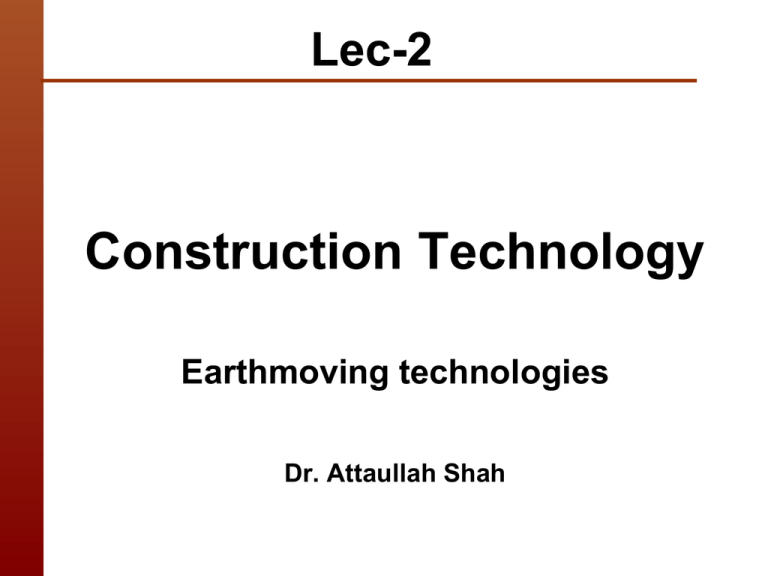
Lec-2
Construction Technology
Earthmoving technologies
Dr. Attaullah Shah
INTRODUCTION TO EARTHMOVING
The Earthmoving Process
– Earthmoving is the process of moving soil or rock from one
location to another and processing it so that it meets
construction requirements of location, elevation, density,
moisture content, and so on.
– Activities involved in this process include excavating,
loading, hauling, placing (dumping and spreading),
compacting, grading, and finishing
INTRODUCTION TO EARTHMOVING
• Equipment Selection
– The choice of equipment to be used on a construction
project has a major influence on the efficiency and
profitability of the construction operation. Hence return on
investment is the major factor.
– Other factors include possible future use of the
equipment, its availability, the availability of parts and
service, and the effect of equipment down time on other
construction equipment and operations- Any other?
– After selection of equipment next most important step is
to develop plan for effective utilization.
– The final phase of the process is, of course, competent
job management to assure compliance with the operating
plan and to make adjustments for unexpected conditions
INTRODUCTION TO EARTHMOVING
• Production of Earthmoving Equipment
– The basic relationship for estimating the production of all
earthmoving equipment is as follows:
– Production = Volume per cycle * Cycles per hour
• The term "volume per cycle" should represent the average
volume of material moved per equipment cycle. Thus the
nominal capacity of the excavator or haul unit must be
modified by an appropriate fill factor based on the type of
material and equipment involved.
• The term "cycles per hour" must include any appropriate
efficiency factors, so that it represents the number of cycles
actually achieved (or expected to be achieved) per hour.
– Cost per unit of production =Equipment cost per hour/Equip prod per
hour
Efficiency of earthmoving equipment
• Management conditions include:
– Skill, training, and motivation of workers. Selection, operation, and
maintenance of equipment. Planning, job layout, supervision, and
coordination of work
• Job conditions are the physical conditions of a job that affect
the production rate (not including the type of material involved). They
include: Topography and work dimensions, surface and weather
conditions. Specification requirements for work methods or sequence.
EARTHMOVING MATERIALS
• Soil and Rock
• Soil and rock are the materials that make up the crust of the
earth and are, therefore, the materials of interest to the
constructor and Engineers.
• General Soil Characteristics
• Trafficability is the ability of a soil to support the weight of
vehicles under repeated traffic. In construction, trafficability
controls the amount and type of traffic that can use unimproved
access roads, as well as the operation of earthmoving equipment
within the construction area. Trafficability is primarily a function of
soil type and moisture conditions
• Loadability is a measure of the difficulty in excavating and
loading a soil. Loose granular soils are highly loadable,
whereas compacted cohesive soils and rock have low
loadability.
SOIL IDENTIFICATION AND
CLASSIFICATION
• Soil is considered to consist of five fundamental material
types: gravel, sand, silt, clay, and organic material.
– Gravels : particles larger than about ¼ in. (6 mm) in
diameter but smaller than 3 in. (76 mm) in diameter. Rock
particles larger than 3 in. (76 mm) in diameter are called
cobbles or boulders.
– Sand is material smaller than gravel but larger than the
No.200 sieve opening (0. 7 mm).
– Silt particles pass the No. 200 sieve but are larger than
0.002 mm.
– Clay is composed of particles less than 0.002 mm in
diameter. Organic soils contain partially decomposed
vegetable matter. Peat is a highly organic soil having a
fibrous texture. It is normally readily identified by its dark
color, odor, and spongy feel. Not suitable for construction
SOIL IDENTIFICATION AND
CLASSIFICATION
• Soil Classification Systems
– Two principal soil classification systems are used for
design and construction:
• Unified System
• AASHTO [American Association of State Highway and
Transportation Officials, formerly known as the American
Association of State Highway Officials (AASHO)] System.
• In both systems, soil particles 3 in. or larger in diameter are
removed before performing classification tests.
SOIL IDENTIFICATION AND
CLASSIFICATION
Table 2-2. Unified system of soil classification—field identification
SOIL IDENTIFICATION AND
CLASSIFICATION
FIGURE 2-1. Typical gradation curves for coarse-grained soils. (U.S. Army Engineer School)
SOIL IDENTIFICATION AND
CLASSIFICATION
• Field Identification of Soil (Unified System)
– Dry Strength Test
– Shaking Test
• Construction Characteristics of Soils
SOIL IDENTIFICATION AND
CLASSIFICATION
SOIL VOLUME-CHANGE
CHARACTERISTICS
• Soil Conditions
– Bank: Material in its natural state before
disturbance. Often referred to as “in-place” or “in
situ.”A unit volume is identified as a bank cubic yard
(BCY) or a bank cubic meter (BCM).
– Loose: Material that has been excavated or loaded.
A unit volume is identified as a loose cubic yard
(LCY) or loose cubic meter (LCM).
– Compacted: Material after compaction. A unit
volume is identified as a compacted cubic yard
(CCY) or compacted cubic meter (CCM).
SOIL VOLUME-CHANGE
CHARACTERISTICS
• Construction characteristics of soils (Unified System)
SOIL VOLUME-CHANGE
CHARACTERISTICS
• Swell: The increase in soil volume after excavation.
• Shrinkage: When a soil is compacted, some of the air is
forced out of the soil's void spaces. As a result, the soil will
occupy less volume than it did under either the bank or
loose conditions. This phenomenon, which is the reverse of
the swell phenomenon, is called shrinkage.
FIGURE 2-2. Typical soil volume change during earthmoving.
• Load and Shrinkage Factors
• Because haul unit and spoil bank volume are commonly
expressed in loose measure, it is convenient to have a
conversion factor to simplify the conversion of loose volume
to bank volume. The factor used for this purpose is caned a
load factor.
• shrinkage factor.
• A factor used for the conversion of bank volume to
compacted volume is sometimes referred to as a shrinkage
factor.
SOIL VOLUME-CHANGE
CHARACTERISTICS
Table 2-5. Typical soil weight and volume change characteristics*
SPOIL BANKS
• When planning and estimating earthwork, it is frequently
necessary to determine the size of the pile of material that
will be created by the material removed from the
excavation. If the pile of material is long in relation to its
width, it is referred to as a spoil bank. Spoil banks are
characterized by a triangular cross section
• To determine the dimensions of spoil banks or piles, it is
first necessary to convert the volume of excavation from inplace conditions (BCY or BCM) to loose conditions (LCY or
LCM). Bank or pile dimensions may then be calculated
using Equations 2-10 to 2-13 if the soil's angle of repose is
known.
• A soil's angle of repose is the angle that the sides of a spoil
bank or pile naturally form with the horizontal when the
excavated soil is dumped onto the pile.
SPOIL BANKS
Table 2-6. Typical values of angle of repose of excavated soil
SPOIL BANKS
• Triangular Spoil Bank
ESTIMATING EARTHWORK VOLUME
• When planning or estimating an earthmoving project, it is
often necessary to estimate the volume of material to be
excavated or placed as fill.
• The procedures to be followed can be divided into three
principal categories:
– (1) pit excavations (small, relatively deep excavations such as
those required for basements and foundations)
– (2) trench excavation for utility lines
– (3) excavating or grading relatively large areas
• Procedures suggested for each of these three cases are
described in the following sections.
ESTIMATING EARTHWORK VOLUME
• Pit Excavations =
• To perform these calculations, first
divide the horizontal area into a
convenient set of rectangles, triangles,
or circular segments. After the area of
each segment has been calculated, the
total area is found as the sum of the
segment areas. The average depth is
then calculated. For simple rectangular
excavations, the average depth can be
taken as simply the average of the four
comer depths.
• Trench Excavations
• The volume of excavation required for a
trench can be calculated as the product
of the trench cross-sectional area and
the linear distance along the trench line
• Volume = Cross-sectional area X Length
FIGURE 2-3. Figure for Example 2-6
ESTIMATING EARTHWORK VOLUME
FIGURE 2-4. Figure for Example 2-8.
CONSTRUCTION USE OF THE MASS DIAGRAM
- A mass diagram is a continuous curve
representing the accumulated volume of earthwork
plotted against the linear profile
of a roadway or airfield.
-Mass diagrams are prepared by highway and
airfield designers to assist in selecting an
alignment which minimizes the earthwork required
to construct the facility while meeting established FIGURE 2-5. A mass diagram.
limits of roadway grade and curvature
-Characteristics of a Mass Diagram
-The vertical coordinate of the mass diagram corresponding to any location on the
road way profile represents the cumulative earthwork volume from the origin to that
point. - Within a cut, the curve rises from left to right.
• Within a fill, the curve falls from left to right.
• A peak on the curve represents a point where the earthwork changes from cut to
fill.
• A valley (low point) on the curve represents a point where the earthwork changes
from fill to cut.
• When a horizontal line intersects the curve at two or more points, the accumulated
volumes at these points are equal. Thus, such a line represents a balance line on
the diagram.
CONSTRUCTION USE OF THE MASS DIAGRAM
Using the Mass Diagram
– The length and direction of haul within a balanced section.
– The average length of haul for a balanced section.
– The location and amount of borrow (material hauled in from a
borrow pit) and waste (material hauled away to a waste area)
for the project.
• Excavation and Lift of earthworks
INTRODUCTION
• Excavating and Lifting Equipment
– An excavator is defined as a power-driven
digging machine.
– The major types of excavators used in
earthmoving operations include hydraulic
excavators and the members of the cableoperated crane-shovel family (shovels,
draglines, hoes, and clamshells).
• Dozers, loaders, and scrapers can also serve
as excavators.
INTRODUCTION
• Excavators and Crane Shovels
• Some of many attachments for the hydraulic
excavator and their uses include:
• Arms,, extendible: Replaces the standard stick to
FIGURE 3-1. Hydraulic
excavator. (Courtesy of
provide extra reach.
Volvo Construction
Equipment North America,
• Auger: Drills holes for poles, posts, soil sampling,
Inc.)
and ground improvement
• Booms: Extended booms used for long-reach applications.
• Breaker/hammer: Vibratory hammer used to break up concrete and rock.
• Bucket, 4-in-1: Also called a multipurpose bucket or multi-segment
bucket. Bucket, articulating clam: A hydraulic clamshell bucket with full
rotation.
• Bucket, cemetery: Used for digging straight wall trenches.
• Bucket, clamshell: Performs like the clamshell described in Section 3-5.
• Bucket, ditch cleaning: Wide, shallow, and smooth-edged bucket; may
be perforated for drainage.
•
•
•
•
•
•
•
•
•
•
•
•
•
•
•
•
Bucket, drop center: Used for trenching. The drop center excavates for pipe
bedding while the sides excavate to the required trench width.
Bucket, general purpose: Standard excavator bucket.
Bucket, muck: Used for excavating mud and muck; usually perforated for
drainage.
Bucket, pavement removal: A forked bucket used for removing and loading
pavement slabs.
Bucket, ripper: The bucket sides and bottom are lined with ripper teeth to break
up hard soil or soft rock.
Bucket, rock: A heavy-duty bucket designed for loading rock.
Bucket, sand: Has a flat bottom and tapered sides to reduce the chance of soil
cave-in.
Bucket, side tilting: Can be tilted for grading slopes and for ditching.
Compaction plate/tamper: - Compaction wheel:
Coupler, quick: Permits rapid exchange of attachments.
Cutter/processor: Power jaws primarily used for crushing concrete.
Drill, rock: Mounted on the end of the stick to drill blast holes.
Grapple: Equipped with tong-type arms for handling rock, logs, and other
materials. - Pile driver/extractor: Used for driving and extracting piles;
Shear: Primarily used for processing scrap metal but also used for emolition.
Thumb, bucket: Attached to bucket to provide a hook capability.
It can be retracted when not needed.
Crane Tools
INTRODUCTION
Excavators and crane-shovels consist of three major assemblies: a carrier
or mounting, a revolving superstructure containing the power and control
units (also called the revolving deck or turntable), and a front-end assembly.
HYDRAULIC EXCAVATORS
• Operation and Employment
– The original and most common form of hydraulically
powered excavator is the hydraulic excavator equipped
with a hoe front end.
– This machine is also called a hydraulic hoe or hydraulic
excavator-backhoe.
– A backhoe (or simply hoe) is an excavator designed
primarily for excavation below grade.
FIGURE 3-3. Components of a hydraulic excavator backhoe.
HYDRAULIC EXCAVATORS
FIGURE 3-3. Components of a hydraulic excavator backhoe.
HYDRAULIC EXCAVATORS
FIGURE 3-4. Telescoping-boom hydraulic excavator. (Courtesy of JLG Industries, Inc.)
HYDRAULIC EXCAVATORS
FIGURE 3-5. Mini-excavator. (Courtesy of JCB Inc.)
HYDRAULIC EXCAVATORS
• Production Estimating
• No production Tables have been prepared for the hydraulic
excavator. However, production may be estimated by using
Equation 3-1 together with Tables 3-3 and 3-4, which have been
prepared from manufacturers' data.
HYDRAULIC EXCAVATORS
job Management
In selecting the proper excavator for a project, consideration
must be given to the maximum depth, working radius, and
dumping height required. Check also for adequate clearance
for the carrier, superstructure, and boom during operation.
Although the excavator will excavate fairly hard material, do
not use the bucket as a sledge in attempting to fracture rock.
Light blasting, ripping, or use of a power hammer may be
necessary to loosen rock sufficiently for excavation.
When lifting pipe into place do not exceed load given in the
manufacturer's safe capacity chart for the situation.
SHOVELS
• Operation and Employment
– Front shovel or hydraulic excavator-front shovel
– Both front-dump and bottom-dump buckets are
available for hydraulic shovels. Bottom dump
buckets are more versatile, provide greater
reach and dump clearance, and produce less
spillage..
FIGURE 3-6. Hydraulic
shovel.
Although the shovel has a limited ability to dig below track level, it
is most efficient when digging above track level.
Other excavators (such as the hydraulic excavator and dragline) are
better suited than the shovel for excavating below ground level
The shovel should have a vertical face to dig against for most
effective digging. This surface, known as the digging face, is easily
formed when excavating a bank or hillside. When the material to be
excavated is located below ground level, the shovel must dig a
ramp down into the material until a digging face of suitable height is
created. This process is known as ramping down.
SHOVELS
FIGURE 3-7. Components of a hydraulic shovel.
SHOVELS
FIGURE 3-8. Digging action of a hydraulic
shovel.
FIGURE 3-9. Shovel approach methods.
• Production Estimating
– Production for hydraulic shovels may be estimated using
Equation 3-2 together with Table 3-6, which has been prepared
from manufacturers' data.
Table 3-6. Standard cycles per hour for hydraulic shovels
• Job Management
• The two major factors controlling shovel production are:
– The swing angle and
– Lost time during the production cycle.
Therefore, the angle of swing between digging and dumping
positions should always be kept to a minimum. Haul units must
be positioned to minimize the time lost as units enter and leave
the loading position.
The floor of the cut should be kept smooth to provide an even
footing for the shovel and to facilitate movement in the cut
area. The shovel should be moved up frequently to keep it at an
optimum distance from the working face. Keeping dipper teeth
sharp will also increase production.
FRONT SHOVEL
FRONT SHOVEL
BACK HOE
BACK HOE
DRAGLINES
• Operation and Employment:
• The dragline is a very versatile machine that has the longest
reach for digging and dumping of any member of the craneshovel family. It can dig from above machine level to
significant depths in soft to medium-hard material.
FIGURE 3-10. Components of a dragline.
FIGURE 3-11. Dragline bucket.
• It does not have the positive digging action or lateral control of
the shovel. Hence the bucket may bounce or move sideways
during hard digging. –leading to more spillage .
• While a skilled dragline operator can overcome many of these
limitations, the size of haul units used for dragline loading
should be greater than that of those used with a similar-size
shovel.
• The maximum bucket size to be used on a dragline depends on
machine power, boom length, and material weight. Therefore,
use the dragline capacity chart provided by the manufacturer
instead of the machine's lifting capacity chart to determine
maximum allowable bucket size.
54
• Production Estimating
•
Expected production= Ideal output X Swing-depth factor X Efficiency
Dragline
Job Management
• Trial operations may be necessary to select the boom
length, boom angle, bucket size and weight, and the
attachment position of the drag chain that yield maximum
production
• In general, the lightest bucket capable of satisfactory
digging should be used, since this increases the allowable
bucket size and reduces cycle time.
• It has been found that the most efficient digging area is
located within 15° forward and back of a vertical line
through the boom point, as illustrated in Figure3-12.
• Special bucket hiltches are available which shorten the
• drag distance necessary to obtain a full bucket load. Deep
cuts should be excavated in layers whose thickness is as
close to the optimum depth of cut as possible.
CLAMSHELLS
FIGURE 3-12. Most efficient digging area for a dragline.
CLAMSHELLS
Clamshells are commonly used for
excavating
vertical
shafts
and
footings, unloading bulk materials
from rail cars and ships, and moving
bulk material from stockpiles to bins,
hoppers, or haul units
When the closing line is released, the
counterweights cause the bucket
halves to open as the bucket is held
by the holding line. Bucket
penetration depends on bucket
weight assisted by the bucket teeth.
Heavy buckets: medium soils.
Medium buckets: general-purpose
work,
Light buckets: For handling bulk
materials such as sand and gravel.
FIGURE 3-13. Components of a clamshell.
FIGURE 3-14. Clamshell bucket.
FIGURE 3-15. Orange peel bucket.
(Courtesy of ESCO Corporation)
TRENCHING AND TRENCHLESS
TECHNOLOGY
• Trenching Machines and Plows:
– There is a growing demand for methods of installing
utility systems below the ground with minimum open
excavation. Some of the machines are:
• Chain trenchers, ladder trenchers, and bucket wheel
trenchers
• Plows can be used to cut a narrow trench and
simultaneously insert a small diameter cable or
pipeline in most soils.
• Vibratory plows deliver a more powerful cutting action
than static plows and can be used to insert utility lines
in hard soil or soft rock.
TRENCHING AND TRENCHLESS
TECHNOLOGY
FIGURE 3-17. Hydrostatic vibratory plow.
(Copyright © Vermeer Manufacturing
Company, All Rights Reserved)
FIGURE 3-16. Chain trencher. (Copyright ©
Vermeer Manufacturing Company, All Rights
Reserved)
TRENCHING AND TRENCHLESS
TECHNOLOGY
• The principal categories include pipe jacking, horizontal
earth boring, and micro-tunneling.
• The process of pipe jacking involves forcing pipe
horizontally through the soil
• Working from a vertical shaft, a section of pipe is carefully
aligned and advanced through the soil by hydraulic jacks
braced against the shaft sides
• Spoil is removed and workers are moved inside during
work
FIGURE 3-18. Installing a utility line by pipe jacking.
TRENCHING AND TRENCHLESS
TECHNOLOGY
-In horizontal earth boring a horizontal hole is created mechanically
or hydraulically with the pipe to be installed serving as the casing for
the hole. Some of the methods for boring include:
- Auger boring, rod pushing (thrust boring), rotational compaction
boring, impact piercing, horizontal directional drilling, and fluid
boring etc.
-Modern technologies technologies utilize lasers and television
cameras for hole alignment and boring control
FIGURE 3-19. Thrust boring machine with
percussive action. (Courtesy of TT
Technologies, Inc.)
FIGURE 3-20. Installing a utility line by horizontal earth boring.
TRENCHING AND TRENCHLESS
TECHNOLOGY
– Microtunneling or utility tunneling is similar to the conventional
tunneling except for the tunnel size and use.
– Since the tunnels are used for utility systems rather than for vehicle
passage, they are normally smaller than road or rail tunnels
- Repair and Rehabilitation of Pipelines
• The repair and rehabilitation of existing pipelines without excavation is
another form of trenchless technology.
• The relining of a pipeline is accomplished by pulling a new plastic pipe
into the existing pipe or by inserting a liner into the existing pipe. The
resulting pipe must be slightly smaller than the original pipe
• Pipe bursting uses a high-powered hydraulic or pneumatic piercing
tool equipped with a special bursting head to shatter the existing pipe
and enlarge the opening. A new, often larger, pipe is then pulled into
the opening by the piercing head.
TRENCHING AND TRENCHLESS
TECHNOLOGY
FIGURE 3-22. Schematic of pneumatic pipe bursting
method. (Courtesy of Earth Tool Company LLC)
FIGURE 3-21. Vacuum excavator.
(Photograph © Federal Signal
Corporation. Used by permission. All
rights reserved.)
CRANES
• Cranes are primarily used for lifting, lowering, and transporting
loads. They move loads horizontally by swinging or traveling
• The major factor controlling the load that may be safely lifted by a
crane is its operating radius
• A standard method of rating the capacity of mobile cranes has
been adopted by the PCSA Bureau of the Association of
Equipment Manufacturers
The PCSA class number following the nominal
rating consists of two number symbols. The
first number indicates the operating radius for
the nominal capacity. The second number
gives the rated load in hundreds of pounds at a
40-ft (12.2-m) operating radius using a 50-ft
(15.2-m) boom.
FIGURE 3-23. Components of a crane.
CRANES
FIGURE 3-24. Large mobile hydraulic
crane with telescoping boom. (Courtesy
of Manitowoc)
CRANES
FIGURE 3-25. Crane load capacity chart.
(Courtesy of Manitowoc)
CRANES
FIGURE 3-26. Large crawlermounted
lattice-boom mobile crane. (Courtesy of
Manitowoc)
CRANES
FIGURE 3-27. Crane with ring
attachment. (Courtesy of Manitowoc)
CRANES
FIGURE 3-28. Tower crane on a building site. (Courtesy of Manitowoc)
CRANES
FIGURE 3-29. Major types of tower cranes.
CRANES
FIGURE 3-30. Terminology of a horizontal
jib tower crane. (Courtesy of Manitowoc)
CRANES
CRANES
FIGURE 3-32. Crane boom attachments. (Reproduced with permission from the
Association of Equipment Manufacturers.)
COMPARING THE COSTS – TRENCHLESS
VERSUS TRADITIONAL METHODS ( New Zealand)
Steve Apeldoorn
CONCLUSIONS: There is plenty of evidence that in many cases
Trenchless Technology is a significantly cheaper and more socially
acceptable method of construction when compared to open-cut
pipeline installation.
• The cost of Trenchless Rehabilitation in New Zealand is decreasing
as the market becomes more mature and development of
technology acts to reduce the unit rates. At the same time, the cost
of open cut repairs and replacement become more expensive as the
cost of fuels, disposal of waste and environmental and social
impacts increase.
• Global warming and an increased awareness of the environment
demands that we adopt methods that will help to reduce carbon
emissions. Trenchless Technology produces 97% less emissions
than open-cut pipeline construction. When considering pipe
replacement or repair methods the full cost, including social costs,
should be taken into account as part of the Life Cycle costing to
ensure that the best method with the overall lowest total cost is
selected. Increasingly, trenchless methodologies will provide that
result.








